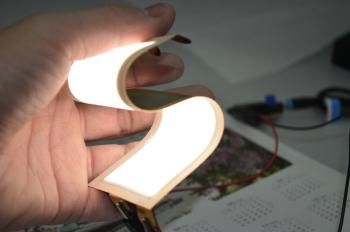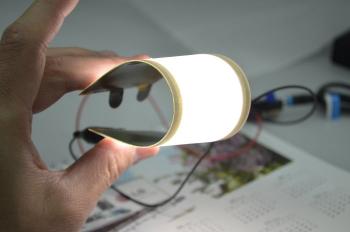In February 2013 LG Chem unveiled their flexible OLED lighting panels, with plans to start producing them in July 2013 (they now aim to do so in September 2013, a slight delay). Those panels use a thin-glass substrate and a metal protective layer with LG Chem's Face-Seal encapsulation.

Today LG Chem announced that they developed new plastic-based (transparent polyimide) OLED lighting panels (shown in the photos above and below). These panels are more bendable (see photo above) than the current metal/glass ones, and LG Chem refers to them as "Plastic Film type Truly-Flexible OLED Panels". The company aims to mass produce these new panels in H1 2015. The new panels are even lighter than the current ones (which are only 0.33 mm thick and weigh under 8 grams).

I don't have a lot of technical details about those panels yet. LG Chem says that the panels are produced using new processes and technologies: the panels use a transparent polyimide substrate and they are bottom-emissive. They are using a new substrate coating technology (which will reduce costs) and new barrier technologies.
Comments
Thanks Rodrigo!
Samung have also decided to use amorf polyamide for their coming "Youm" displays
on flexible Amoled substrate.
Amorf polyamide have 2 interesting properties:
1.It pass higher temperature than crystalline polyamide, which makes it suitable for substrate
for an Amoled display which can be heated up by many hours use.
2.Amorf polyamide is transparent o both oled as light source and display
can be partially or totally transparent.
I thought that the orginial article mentioned transparent PI for LG's flexible OLED. You wrote polyamide. I do not believe that these are the same materials.
Anyway, do you have any cost estimates for the cost of the substrate and that of their Face-Seal barrier technology?


Please correct a typo in the text. Replace "then" with "than" in this sentence:
"These panels are more bendable (see photo above) then the current metal/glass ones"
Rodrigo Valle